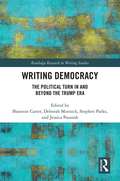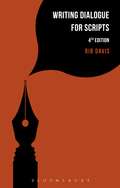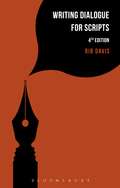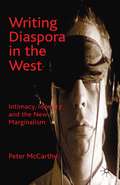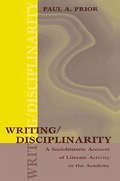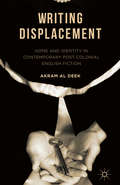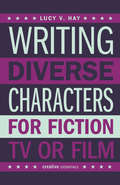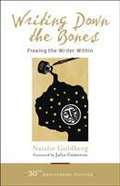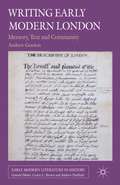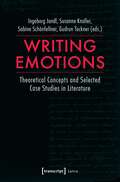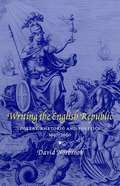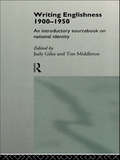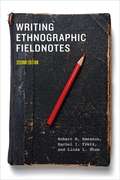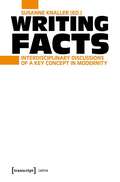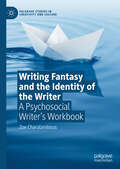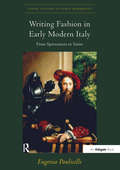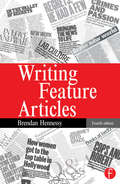- Table View
- List View
Writing Democracy: The Political Turn in and Beyond the Trump Era (Routledge Research in Writing Studies)
by Shannon Carter Deborah Mutnick Jessica Pauszek Stephen ParksWriting Democracy: The Political Turn in and Beyond the Trump Era calls on the field of writing studies to take up a necessary agenda of social and economic change in its classrooms, its scholarship, and its communities to challenge the rise of neoliberalism and right-wing nationalism. Grown out of an extended national dialogue among public intellectuals, academic scholars, and writing teachers, collectively known as the Writing Democracy project, the book creates a strategic roadmap for how to reclaim the progressive and political possibilities of our field in response to the "twilight of neoliberalism" (Cox and Nilsen), ascendant right-wing nationalism at home (Trump) and abroad (Le Pen, Golden Dawn, UKIP), and hopeful radical uprisings (Black Lives Matter, Occupy Wall Street, Arab Spring). As such, the book tracks the emergence of a renewed left wing in rhetoric and activism post-2008, suggests how our work as teachers, scholars, and administrators can bring this new progressive framework into our institutions, and then moves outward to our role in activist campaigns that are reshaping public debate. Part history, part theory, this book will be an essential read for faculty, graduate students, and advanced undergraduate students in composition and rhetoric and related fields focused on progressive pedagogy, university-community partnerships, and politics.
Writing Dialogue for Scripts (Writing Handbooks)
by Rib DavisA good story can easily be ruined by bad dialogue. Now in its 4th edition, Rib Davis's bestselling Writing Dialogue for Scripts provides expert insight into how dialogue works, what to look out for in everyday speech and how to use dialogue effectively in scripts. Examining practical examples from film, TV, theatre and radio, this book will help aspiring and professional writers alike perfect their skills. The 4th edition of Writing Dialogue for Scripts includes: a look at recent films, such as American Hustle and Blue Jasmine; TV shows such as Mad Men and Peaky Blinders; and the award winning play, Ruined. Extended material on use of narration within scripts (for example in Peep Show) and dialogue in verbatim scripts (Alecky Blythe's London Road) also features.
Writing Dialogue for Scripts (Writing Handbooks)
by Rib DavisA good story can easily be ruined by bad dialogue. Now in its 4th edition, Rib Davis's bestselling Writing Dialogue for Scripts provides expert insight into how dialogue works, what to look out for in everyday speech and how to use dialogue effectively in scripts. Examining practical examples from film, TV, theatre and radio, this book will help aspiring and professional writers alike perfect their skills. The 4th edition of Writing Dialogue for Scripts includes: a look at recent films, such as American Hustle and Blue Jasmine; TV shows such as Mad Men and Peaky Blinders; and the award winning play, Ruined. Extended material on use of narration within scripts (for example in Peep Show) and dialogue in verbatim scripts (Alecky Blythe's London Road) also features.
Writing Diaspora in the West: Intimacy, Identity and the New Marginalism
by P. McCarthyIn this bold intervention into the understanding of the diasporic experience within cultural studies, McCarthy challenges a critical position emergent over the last thirty years (what he calls the 'new marginalism'). He confronts the liberal orthodoxies that prevail in this area, exposing contradictions in the thinking of its major theorists.
Writing/Disciplinarity: A Sociohistoric Account of Literate Activity in the Academy (Rhetoric, Knowledge, and Society Series)
by Paul PriorOver the past century, the explosive growth of scientific, technical, and cultural disciplines has profoundly affected our daily lives. However, processes of enculturation in sites such as graduate education that have helped to form these disciplines have received very limited research attention. In those sites, graduate students write diverse documents, including course papers, departmental examinations, theses and dissertations, grant and fellowship applications, and disciplinary publications. Thus, writing is one of the central domains of enculturation--an activity through which graduate students and professors display and negotiate disciplinary knowledge, genres, identities, and institutional contexts. This volume explores this intersection of writing and disciplinary enculturation through a series of ethnographic case studies. These case studies provide the most thorough descriptions available today of the lived experience of graduate seminars, combining analysis of classroom talk, students' texts and professor's written responses, institutional contexts, students' representations of their writing and its contexts, and professors' representations of their tasks and their students. Given the complexities that the ethnographic data displayed, the author found that conventional notions of writing as a process of transcription and of disciplines as unified discourse communities were inadequate. As such, this book also offers an in-depth exploration of sociohistoric theory in relation to writing and disciplinary enculturation. Specific case studies introduce, apply, and further elaborate notions of: * writing as literate activity, * authorship as mediated by other people and artifacts, * classroom tasks as speech genres, * enculturation as the interplay of authoritative and internally persuasive discourses, and * disciplinarity as a deeply heterogeneous, laminated, and dialogic process. This blend of research and theory should be of interest to scholars and students in such fields as writing studies, rhetoric, writing across the curriculum, applied linguistics, English for academic purposes, science and technology studies, higher education, and the ethnography of communication.
Writing/Disciplinarity: A Sociohistoric Account of Literate Activity in the Academy (Rhetoric, Knowledge, and Society Series)
by Paul PriorOver the past century, the explosive growth of scientific, technical, and cultural disciplines has profoundly affected our daily lives. However, processes of enculturation in sites such as graduate education that have helped to form these disciplines have received very limited research attention. In those sites, graduate students write diverse documents, including course papers, departmental examinations, theses and dissertations, grant and fellowship applications, and disciplinary publications. Thus, writing is one of the central domains of enculturation--an activity through which graduate students and professors display and negotiate disciplinary knowledge, genres, identities, and institutional contexts. This volume explores this intersection of writing and disciplinary enculturation through a series of ethnographic case studies. These case studies provide the most thorough descriptions available today of the lived experience of graduate seminars, combining analysis of classroom talk, students' texts and professor's written responses, institutional contexts, students' representations of their writing and its contexts, and professors' representations of their tasks and their students. Given the complexities that the ethnographic data displayed, the author found that conventional notions of writing as a process of transcription and of disciplines as unified discourse communities were inadequate. As such, this book also offers an in-depth exploration of sociohistoric theory in relation to writing and disciplinary enculturation. Specific case studies introduce, apply, and further elaborate notions of: * writing as literate activity, * authorship as mediated by other people and artifacts, * classroom tasks as speech genres, * enculturation as the interplay of authoritative and internally persuasive discourses, and * disciplinarity as a deeply heterogeneous, laminated, and dialogic process. This blend of research and theory should be of interest to scholars and students in such fields as writing studies, rhetoric, writing across the curriculum, applied linguistics, English for academic purposes, science and technology studies, higher education, and the ethnography of communication.
Writing Displacement: Home and Identity in Contemporary Post-Colonial English Fiction
by Akram Al DeekUses the Palestinian exilic displacements as a tool and compass to find intersecting points of reference with the Caribbean, Indian, African, Chinese, and Pakistani dispersions, Writing Displacement studies the metamorphosis of the politics of home and identity amongst different migrant nationals from the end of WWII into the new millennium.
Writing Diverse Characters For Fiction, TV or Film: An Essential Guide for Authors and Script Writers
by Lucy V. HayWe're living in a time of unprecedented diversity in produced media content, with more characters appearing who are Black, Asian and Minority Ethnic (BAME), Lesbian, Gay, Bisexual and Transgender (LGBT), disabled, or from other religions or classes. What's more, these characters are increasingly appearing in genre pieces, accessible to the mainstream, instead of being hidden away in so-called 'worthier' pieces, as in the past.How to Write Diverse Characters discusses issues of race, disability, sexuality and transgender people with specific reference to characterisation - not only in movies and TV, but also novel writing.Taking in blockbuster movies such as Mad Max Fury Road, Russell T Davies' ground-breaking TV series Cucumber and and the controversial novel Gone Girl, the book explores:How character role function really worksWhat is the difference between stereotype and archetype? Why 'trope' does not mean what Twitter and Tumblr think it meansHow the burden of casting affects both box office and audience perceptionWhy diversity is not about agendas, buzzwords or being 'politically correct'What authenticity truly means and why research is so importantWhy variety is key in ensuring true diversity in characterisationWriters have to catch up. Knowing not only what makes a 'good' diverse character doesn't always cut it; they need to know what agents, publishers, producers, filmmakers and commissioners are looking for - and why.This book gives writers the tools to create three dimensional, authentic characters ... who just happen to be diverse.'A timely guide to creating original characters and reinvigorating tired storylines' - Debbie Moon, creator and showrunner, Wolfblood (BBC)'Lucy V. Hay nails it' - Stephen Volk, BAFTA-winning screenwriter: Ghostwatch, Afterlife, The Awakening'Packed with practical and inspirational insights'- Karol Griffiths, development consultant and script editor, clients include ITV, BBC, Warner Brothers
Writing Down The Bones: Freeing The Writer Within (PDF)
by Natalie Goldberg Julia CameronFor more than thirty years Natalie Goldberg has been challenging and cheering on writers with her books and workshops. In her groundbreaking first book, she brings together Zen meditation and writing in a new way. Writing practice, as she calls it, is no different from other forms of Zen practice—"it is backed by two thousand years of studying the mind." This thirtieth-anniversary edition includes new forewords by Julia Cameron and Bill Addison. It also includes a new preface in which Goldberg reflects on the enduring quality of the teachings here. She writes, "What have I learned about writing over these thirty years? I’ve written fourteen books, and it’s the practice here in Bones that is the foundation, sustaining and building my writing voice, that keeps me honest, teaches me how to endure the hard times and how to drop below discursive thinking, to taste the real meat of our minds and the life around us."
Writing Early Modern London: Memory, Text and Community (Early Modern Literature in History)
by A. GordonWriting Early Modern London explores how urban community in London was experienced, imagined and translated into textual form. Ranging from previously unstudied manuscripts to major works by Middleton, Stow and Whitney, it examines how memory became a key cultural battleground as rites of community were appropriated in creative ways.
Writing Ecofiction: Navigating the Challenges of Environmental Narrative
by Kevan ManwaringThis creative writing textbook introduces students to ecofiction: narrative writing that focuses on the environment. Also known as ‘climate fiction’ or ‘cli-fi’, an increasing number of short story writers, novelists and pioneers of emerging forms such as interactive fiction are taking up the call to develop their own creative responses to the climate crisis. This guide explores a cross-section of genres and ways of writing about our world, as well as the ethical and technical challenges involved. It offers a discussion of classic and contemporary texts, literary criticism and creative writing exercises. The book covers a broad range of themes and styles of writing, from works that engage with nature and landscape writing to those that take a more activist approach to climate change. With an awareness of the Global South and the subaltern, the framing of the Anthropocene, wilderness and nature writing is challenged. Each chapter offers a new perspective on ecofiction for the creative writer, with reading suggestions and connections to other writers and texts, and writing activities. Designed for upper-level undergraduate and postgraduate writing modules on the environment, the book is also suitable for independent writers looking to expand their skillset. Featuring 20 interviews with ecofiction authors: Ana Filomena Amaral, Austin Aslan, Denise Baden, David Barker, TC Boyle, Lynn Buckle, Adam Connor, Michelle Cook, Julie Carrick Dalton, April Doyle, Anna Holmes, Somto Ihezue, RB Kelly, Gill Lewis, Anne Mordell, Anthony Nanson, Midge Raymond, Manda Scott, Mary Woodbury, John Yunker. ‘An extensive and enthusiastic guide into the wild and varied worlds of eco-fiction.’ --James Canton, Director of Wild Writing MA, University of Essex, UK
Writing Emotions: Theoretical Concepts and Selected Case Studies in Literature (Lettre)
by Ingeborg Jandl Susanne Knaller Sabine Schönfellner Gudrun TocknerAfter a long period of neglect, emotions have become an important topic within literary studies. This collection of essays stresses the complex link between aesthetic and non-aesthetic emotional components and discusses emotional patterns by focusing on the practice of writing as well as on the impact of such patterns on receptive processes. Readers interested in the topic will be presented with a concept of aesthetic emotions as formative both within the writing and the reading process. Essays, ranging in focus from the beginning of modern drama to digital formats and theoretical questions, examine examples from English, German, French, Russian and American literature. Contributors include Angela Locatelli, Vera Nünning, and Gesine Lenore Schiewer.
Writing The English Republic: Poetry, Rhetoric And Politics, 1627-1660 (PDF)
by David Norbrook'[Norbrook's] marvellously original, densely researched study of the English republican imagination is an attempt to retrieve forgotten figures like the regicide Henry Marten, as well as to extend our understanding of the works of Milton and Marvell. ' Tom Paulin, The Independent '[A] fine and important book … I suspect that Writing the English Republic will have as large and lasting an impact as any previous or readily foreseeable study of the relationship between literature and politics in seventeenth-century England. [Norbrook] writes in an attractively exploratory spirit which resists dogmatism and the sealing of argument. ' Blair Worden,Times Literary Supplement 'The case for the republican conscience resounds most eloquently in the impressive coda to this book … but the pay-off for historians stems above all from Norbrook's decision to produce a theme-driven argument instead of a general survey. This has led him to dig deep into the textual remains of the Revolution, rather than content himself with the familiar surface structures. ' London Review of Books
Writing Englishness: An Introductory Sourcebook
by Judy Giles Tim MiddletonWhat did it mean in the first half of this century to say `I am English?' A Practical Sourcebook on National Identity is a unique collection of extracts from writing of the era, all of which in some way raise this question. Drawn from a wide range of sources including letters, diaries, journalism, fiction, poems, parliamentary speeches and government reports, the volume is divided into five sections: * The Ideas and Ideals of Englishness * Versions of Rural England * War and National Identity * Culture and Englishness * Domestic and Urban Englands The editors provide an introduction to each section and conclude with suggested study activities and further reading. It also contains a chronology and bibliography, completing the framework for study. A Practical Sourcebook on National Identity is a fascinating collection which will not only be essential and accessible reading for students, but will also appeal to anyone who has ever asked what it means to become part of a national identity.
Writing Englishness: An Introductory Sourcebook
by Judy Giles Tim MiddletonWhat did it mean in the first half of this century to say `I am English?' A Practical Sourcebook on National Identity is a unique collection of extracts from writing of the era, all of which in some way raise this question. Drawn from a wide range of sources including letters, diaries, journalism, fiction, poems, parliamentary speeches and government reports, the volume is divided into five sections: * The Ideas and Ideals of Englishness * Versions of Rural England * War and National Identity * Culture and Englishness * Domestic and Urban Englands The editors provide an introduction to each section and conclude with suggested study activities and further reading. It also contains a chronology and bibliography, completing the framework for study. A Practical Sourcebook on National Identity is a fascinating collection which will not only be essential and accessible reading for students, but will also appeal to anyone who has ever asked what it means to become part of a national identity.
Writing Ethnographic Fieldnotes, Second Edition (Chicago Guides to Writing, Editing, and Publishing)
by Robert M. Emerson Rachel I. Fretz Linda L. ShawIn Writing Ethnographic Fieldnotes, Robert M. Emerson, Rachel I. Fretz, and Linda L. Shaw present a series of guidelines, suggestions, and practical advice for creating useful fieldnotes in a variety of settings, demystifying a process that is often assumed to be intuitive and impossible to teach. Using actual unfinished notes as examples, the authors illustrate options for composing, reviewing, and working fieldnotes into finished texts. They discuss different organizational and descriptive strategies and show how transforming direct observations into vivid descriptions results not simply from good memory but from learning to envision scenes as written. A good ethnographer, they demonstrate, must learn to remember dialogue and movement like an actor, to see colors and shapes like a painter, and to sense moods and rhythms like a poet. This new edition reflects the extensive feedback the authors have received from students and instructors since the first edition was published in 1995. As a result, they have updated the race, class, and gender section, created new sections on coding programs and revising first drafts, and provided new examples of working notes. An essential tool for budding social scientists, the second edition of Writing Ethnographic Fieldnotes will be invaluable for a new generation of researchers entering the field.
Writing Ethnographic Fieldnotes, Second Edition (Chicago Guides to Writing, Editing, and Publishing)
by Robert M. Emerson Rachel I. Fretz Linda L. ShawIn Writing Ethnographic Fieldnotes, Robert M. Emerson, Rachel I. Fretz, and Linda L. Shaw present a series of guidelines, suggestions, and practical advice for creating useful fieldnotes in a variety of settings, demystifying a process that is often assumed to be intuitive and impossible to teach. Using actual unfinished notes as examples, the authors illustrate options for composing, reviewing, and working fieldnotes into finished texts. They discuss different organizational and descriptive strategies and show how transforming direct observations into vivid descriptions results not simply from good memory but from learning to envision scenes as written. A good ethnographer, they demonstrate, must learn to remember dialogue and movement like an actor, to see colors and shapes like a painter, and to sense moods and rhythms like a poet. This new edition reflects the extensive feedback the authors have received from students and instructors since the first edition was published in 1995. As a result, they have updated the race, class, and gender section, created new sections on coding programs and revising first drafts, and provided new examples of working notes. An essential tool for budding social scientists, the second edition of Writing Ethnographic Fieldnotes will be invaluable for a new generation of researchers entering the field.
Writing Ethnographic Fieldnotes, Second Edition (Chicago Guides to Writing, Editing, and Publishing)
by Robert M. Emerson Rachel I. Fretz Linda L. ShawIn Writing Ethnographic Fieldnotes, Robert M. Emerson, Rachel I. Fretz, and Linda L. Shaw present a series of guidelines, suggestions, and practical advice for creating useful fieldnotes in a variety of settings, demystifying a process that is often assumed to be intuitive and impossible to teach. Using actual unfinished notes as examples, the authors illustrate options for composing, reviewing, and working fieldnotes into finished texts. They discuss different organizational and descriptive strategies and show how transforming direct observations into vivid descriptions results not simply from good memory but from learning to envision scenes as written. A good ethnographer, they demonstrate, must learn to remember dialogue and movement like an actor, to see colors and shapes like a painter, and to sense moods and rhythms like a poet. This new edition reflects the extensive feedback the authors have received from students and instructors since the first edition was published in 1995. As a result, they have updated the race, class, and gender section, created new sections on coding programs and revising first drafts, and provided new examples of working notes. An essential tool for budding social scientists, the second edition of Writing Ethnographic Fieldnotes will be invaluable for a new generation of researchers entering the field.
Writing Ethnographic Fieldnotes, Second Edition (Chicago Guides to Writing, Editing, and Publishing)
by Robert M. Emerson Rachel I. Fretz Linda L. ShawIn Writing Ethnographic Fieldnotes, Robert M. Emerson, Rachel I. Fretz, and Linda L. Shaw present a series of guidelines, suggestions, and practical advice for creating useful fieldnotes in a variety of settings, demystifying a process that is often assumed to be intuitive and impossible to teach. Using actual unfinished notes as examples, the authors illustrate options for composing, reviewing, and working fieldnotes into finished texts. They discuss different organizational and descriptive strategies and show how transforming direct observations into vivid descriptions results not simply from good memory but from learning to envision scenes as written. A good ethnographer, they demonstrate, must learn to remember dialogue and movement like an actor, to see colors and shapes like a painter, and to sense moods and rhythms like a poet. This new edition reflects the extensive feedback the authors have received from students and instructors since the first edition was published in 1995. As a result, they have updated the race, class, and gender section, created new sections on coding programs and revising first drafts, and provided new examples of working notes. An essential tool for budding social scientists, the second edition of Writing Ethnographic Fieldnotes will be invaluable for a new generation of researchers entering the field.
Writing Facts: Interdisciplinary Discussions of a Key Concept in Modernity (Lettre)
by Susanne Knaller»Fact« is one of the most crucial inventions of modern times. Susanne Knaller discusses the functions of this powerful notion in the arts and the sciences, its impact on aesthetic models and systems of knowledge. The practice of writing provides an effective procedure to realize and to understand facts. This concerns preparatory procedures, formal choices, models of argumentation, and narrative patterns. By considering »writing facts« and »writing facts«, the volume shows why and how »facts« are a result of knowledge, rules, and norms as well as of description, argumentation, and narration. This approach allows new perspectives on »fact« and its impact on modernity.
Writing Fantasy and the Identity of the Writer: A Psychosocial Writer’s Workbook (Palgrave Studies in Creativity and Culture)
by Zoe CharalambousThis book presents the innovative pedagogy of Writing Fantasy: a method for exploring and shifting one’s identity as a writer. The book draws on qualitative research with undergraduate creative writing students and fills a gap in the literature exploring creative writing pedagogy and creative writing exercises. Based on the potential to shift writer identity through creative writing exercises and the common ground that these share with the stance of the Lacanian analyst, the author provides a set of guidelines, exercises and case studies to trace writing fantasy, evidenced in one’s creative writing texts and responses about creative writing. This innovative work offers fresh insights for scholars of creativity, Lacan and psychosocial studies, and a valuable new resource for students and teachers of creative writing.
Writing Fashion in Early Modern Italy: From Sprezzatura to Satire (Visual Culture in Early Modernity)
by Eugenia PaulicelliThe first comprehensive study on the role of Italian fashion and Italian literature, this book analyzes clothing and fashion as described and represented in literary texts and costume books in the Italy of the 16th and 17th centuries. Writing Fashion in Early Modern Italy emphasizes the centrality of Italian literature and culture for understanding modern theories of fashion and gauging its impact in the shaping of codes of civility and taste in Europe and the West. Using literature to uncover what has been called the ’animatedness of clothing,’ author Eugenia Paulicelli explores the political meanings that clothing produces in public space. At the core of the book is the idea that the texts examined here act as maps that, first, pinpoint the establishment of fashion as a social institution of modernity; and, second, gauge the meaning of clothing at a personal and a political level. As well as Castiglione’s The Book of the Courtier and Cesare Vecellio’s The Clothing of the Renaissance World, the author looks at works by Italian writers whose books are not yet available in English translation, such as those by Giacomo Franco, Arcangela Tarabotti, and Agostino Lampugnani. Paying particular attention to literature and the relevance of clothing in the shaping of codes of civility and style, this volume complements the existing and important works on Italian fashion and material culture in the Renaissance. It makes the case for the centrality of Italian literature and the interconnectedness of texts from a variety of genres for an understanding of the history of Italian style, and serves to contextualize the debate on dress in other European literatures.
Writing Fashion in Early Modern Italy: From Sprezzatura to Satire (Visual Culture in Early Modernity)
by Eugenia PaulicelliThe first comprehensive study on the role of Italian fashion and Italian literature, this book analyzes clothing and fashion as described and represented in literary texts and costume books in the Italy of the 16th and 17th centuries. Writing Fashion in Early Modern Italy emphasizes the centrality of Italian literature and culture for understanding modern theories of fashion and gauging its impact in the shaping of codes of civility and taste in Europe and the West. Using literature to uncover what has been called the ’animatedness of clothing,’ author Eugenia Paulicelli explores the political meanings that clothing produces in public space. At the core of the book is the idea that the texts examined here act as maps that, first, pinpoint the establishment of fashion as a social institution of modernity; and, second, gauge the meaning of clothing at a personal and a political level. As well as Castiglione’s The Book of the Courtier and Cesare Vecellio’s The Clothing of the Renaissance World, the author looks at works by Italian writers whose books are not yet available in English translation, such as those by Giacomo Franco, Arcangela Tarabotti, and Agostino Lampugnani. Paying particular attention to literature and the relevance of clothing in the shaping of codes of civility and style, this volume complements the existing and important works on Italian fashion and material culture in the Renaissance. It makes the case for the centrality of Italian literature and the interconnectedness of texts from a variety of genres for an understanding of the history of Italian style, and serves to contextualize the debate on dress in other European literatures.
Writing Feature Articles
by Brendan HennessyHennessy's classic text tells you everything you need to know about writing successful features. You will learn how to formulate and develop ideas and how to shape them to fit different markets. Now in its fourth edition, Writing Feature Articles has been fully revised and updated to take into account the changing requirements of journalism and media courses. You will also discover how to exploit new technology for both researching and writing online.Learn step-by-step how to plan, research and write articles for a wide variety of 'popular', 'quality' and specialist publications. Discover more and make the advice stick by completing the tasks and reading the keen analysis of extracts from the best of today's writing.Packed with inspirational advice in a friendly, highly readable style, this guide is a must-have for practising and aspiring journalists and writers.
Writing Feature Articles
by Brendan HennessyHennessy's classic text tells you everything you need to know about writing successful features. You will learn how to formulate and develop ideas and how to shape them to fit different markets. Now in its fourth edition, Writing Feature Articles has been fully revised and updated to take into account the changing requirements of journalism and media courses. You will also discover how to exploit new technology for both researching and writing online.Learn step-by-step how to plan, research and write articles for a wide variety of 'popular', 'quality' and specialist publications. Discover more and make the advice stick by completing the tasks and reading the keen analysis of extracts from the best of today's writing.Packed with inspirational advice in a friendly, highly readable style, this guide is a must-have for practising and aspiring journalists and writers.
